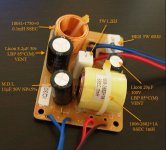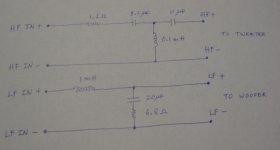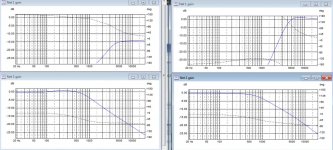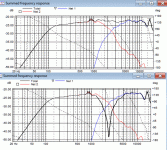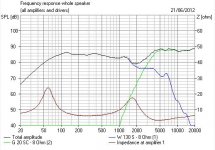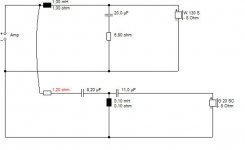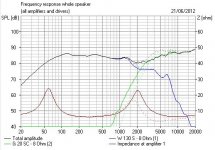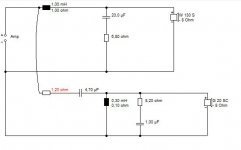Please lets keep this about solid design and engineering principles and not snake oil-esque subjective reviewer propaganda.
The self inductance of any standard wire-wound ceramic/sand cast resistor or of any internal cabling is going to have literally zero impact on your loudspeaker design. Low inductance or non inductive power resistors are meant for high frequency (read MHz etc) applications that are going to be sensitive to very small inductances, where in these cases even the self inductance of the PCB traces are important. There is no need whatsoever to replace the resistors or the internal wiring.
If however you do replace the resistors then it makes sense to buy higher wattage ones otherwise you won't be gaining anything at all by changing them. And if you do want to change the internal wiring then buy some with a PTFE insulator. Why? Because it wont melt when it gets near the soldering iron.
Leave the inductors alone.
Point to point wiring or using a PCB? For the given application both are more then acceptable. Pick which one gives you an easier time when assembling everything. I tend to use point to point wiring for crossovers because they are simple enough that a PCB isn't required and that making a PCB would take me more time and effort then simply using point to point wiring. There is no audio voodoo in either.
The self inductance of any standard wire-wound ceramic/sand cast resistor or of any internal cabling is going to have literally zero impact on your loudspeaker design. Low inductance or non inductive power resistors are meant for high frequency (read MHz etc) applications that are going to be sensitive to very small inductances, where in these cases even the self inductance of the PCB traces are important. There is no need whatsoever to replace the resistors or the internal wiring.
If however you do replace the resistors then it makes sense to buy higher wattage ones otherwise you won't be gaining anything at all by changing them. And if you do want to change the internal wiring then buy some with a PTFE insulator. Why? Because it wont melt when it gets near the soldering iron.
Leave the inductors alone.
Point to point wiring or using a PCB? For the given application both are more then acceptable. Pick which one gives you an easier time when assembling everything. I tend to use point to point wiring for crossovers because they are simple enough that a PCB isn't required and that making a PCB would take me more time and effort then simply using point to point wiring. There is no audio voodoo in either.
I don't think I want to get involved in further debate about components here. There is obviously scope to make a higher quality crossover though, and you're certainly firing both barrels at that. What interested me was what the sound of these speakers is, and how KEF have engineered it, and how sensitive it is going to be to small changes like inductor DCR and capacitor ESR. I simmed it.
It's actually a bit of a horror if you are used to KEF's smoother old BBC type offerings. First order bass, almost no electrical rolloff at all, running with a fairly steep third order metal supertweeter which is fairly traditional. Beyond getting phase roughly matched at crossover, I couldn't get any phase tracking at all. 😕
I would expect these speakers to sound lively on stands, but have considerable harshness coming from the woofer above say 3kHz. So it is confirmed in HiFi World:
At risk of alienating you, this is a speaker I wouldn't buy. It has too many weaknesses and a few strengths. A typical cheaply engineered modern speaker. Initially quite bright and exciting sounding, but just not accurate and ultimately fatigueing. Like the Curate's egg, good in parts, and short of some considerable redesign, hardly worth throwing a lot of money at.
The better capacitors, non-ferrite coil and bigger Zobel resistor are not going to do any harm, but will not change it's basically bright and harsh sound.
It's actually a bit of a horror if you are used to KEF's smoother old BBC type offerings. First order bass, almost no electrical rolloff at all, running with a fairly steep third order metal supertweeter which is fairly traditional. Beyond getting phase roughly matched at crossover, I couldn't get any phase tracking at all. 😕
I would expect these speakers to sound lively on stands, but have considerable harshness coming from the woofer above say 3kHz. So it is confirmed in HiFi World:
KEF iQ30FOR
- clean, solid bass
- tonally wide and even
- superb imaging
AGAINST
- hard edged vocals
- steely treble
- occasionally sibilant
At risk of alienating you, this is a speaker I wouldn't buy. It has too many weaknesses and a few strengths. A typical cheaply engineered modern speaker. Initially quite bright and exciting sounding, but just not accurate and ultimately fatigueing. Like the Curate's egg, good in parts, and short of some considerable redesign, hardly worth throwing a lot of money at.
The better capacitors, non-ferrite coil and bigger Zobel resistor are not going to do any harm, but will not change it's basically bright and harsh sound.
Attachments
At risk of alienating you, this is a speaker I wouldn't buy. It has too many weaknesses and a few strengths.
No worries there, while I got those ones in exchange and while someone insisted I agreed... Otherwise I wouldn't buy them and probably will go for KEF higher end series. Maybe XQ and definitely go for Ref. 201/2.
No worries there, while I got those ones in exchange and while someone insisted I agreed... Otherwise I wouldn't buy them and probably will go for KEF higher end series. Maybe XQ and definitely go for Ref. 201/2.
I was pretty critical of those speakers there. The sort of thing I could improve, but not totally fix, if you follow. The Zingy metallic top would just plain annoy me, and harshness from a woofer is almost unbearable to my ears. 🙂
FWIW, if I was going low order crossover, it would probably be with Morel vented voice coils in polycone and traditional tweeters, but I'd most likely do something more complicated with the crossover:
DIY speakerkits
How do you find the sound anyway? Presumably you are doing stuff to the KEFs because you have an object in mind?
How do you find the sound anyway? Presumably you are doing stuff to the KEFs because you have an object in mind?
I find them a bit on the bright end but that they have a really good stereo soundstage or imaging as some people refers... What I do like to have from them is to keep good soundstage but tame it a bit the high end or smooth it out. A bit softer midrange, while sometimes they sounded a bit too forward in the midrange. Sometimes I liked top end on the KEF's depending on the recording but it does wary with the type of music played on it... Strange... 🙄
To be honest PSB's GB1 sound a more neutral and smoother then KEF's iQ30. I loved the acoustic guitar on the GB1's and on iQ30's the real guitar sound wasn't present or better to say it was coloured... I was on the concert sitting just behind the recording artist when that particular live recording was made and I like always to compare to this my speakers. The PSB's get that right.
I always wondered while IMO the silver wires are always tend to be a bit on the bright side if something can be improved on the high end with using silver but I need to keep low/mid range where it is... What do you think?
You're barking up the wrong tree if you think that components are going to change the basic tonality much, my friend. A RC Zobel across the tweeter is going to transform the top to something a lot smoother.
Midrange harshness will be fixed by changing the woofer Zobel to a proper 2nd order with, say, 10uF or 20Uf and 1 ohm resistor replacing it. Couldn't suggest exact values without looking at a Sim and knowing the DC resistance of the drivers though. Might even consider a 1uF tank across the woofer coil to rolloff the bass around 5kHz as well.
This is real DIYaudio, not just fiddling. 😎
Midrange harshness will be fixed by changing the woofer Zobel to a proper 2nd order with, say, 10uF or 20Uf and 1 ohm resistor replacing it. Couldn't suggest exact values without looking at a Sim and knowing the DC resistance of the drivers though. Might even consider a 1uF tank across the woofer coil to rolloff the bass around 5kHz as well.
This is real DIYaudio, not just fiddling. 😎
You're barking up the wrong tree if you think that components are going to change the basic tonality much, my friend.
Everyone has his opinion but on this I must disagree while I heard already a moded iQ30 and as long as I can remember it was done only by changing the x-over components and sound sonically changed a lot. That's why I am interested to mod iQ30 while you really hear the difference. I been told that driver can do much more then it does. Just waiting to get service manual...
Everyone has his opinion but on this I must disagree while I heard already a moded iQ30 and as long as I can remember it was done only by changing the x-over components and sound sonically changed a lot. That's why I am interested to mod iQ30 while you really hear the difference. I been told that driver can do much more then it does. Just waiting to get service manual...
You're misunderstanding me there. Right from the start I've agreed with better polycaps. Lose the ferrite coil too. After that you are well down the slope of diminishing returns.
Cables and resistor changes shouldn't make a lot of difference, and, FWIW, cable changes affect sound because they present a changed load to a class AB amplifier at the top end IMO. Transistor amps are very sensitive to high frequency load. It can dramatically change the Q at rolloff. Perhaps up to 3dB change in HF level.
What I'm saying is that it WILL sound smoother and more detailed, but you aren't going to fix the deficiencies of the drivers and crossover that way. That requires work on redesigning the crossover.
There isn't anything tragically wrong with the KEF crossover although it might not be perfect.
Below you can see a comparison of a loudspeaker I designed on the left with the KEF on the right.

The graphs show the electrical transfer functions of what the filters do. Tweeters on the top, woofers on the bottom. Reasonably standard values for Re and Le, for 8 ohm drivers, were chosen for the simulation of the KEF xover.
Both the KEF and my design use almost identical topologies, first order and zobel on the woofer with a third order + resistor on the tweeter. I used an L-pad on the tweeter whereas KEF just used a single resistor.
As can be seen the transfer functions follow very similar trends. The electrical phase of the tweeter crossovers is quite different, but that's not a surprise, the KEF uses a co-incident driver, whereas my design does not and was also designed for an odd listening axis too, well above the height of the loudspeaker.
How does this xover perform when combined with the drivers acoustic response?

Extremely well.
Of course this isn't to say that the KEF crossover is flawless, the point however is that the topology does indeed work.
Huh? First you say cables and resistor changes shouldn't make a lot of difference and then you go on to say that small change in the load can affect the frequency response by up to 3dB in places. Which one is it? You can't have both.
For what it's worth transistor amps are extremely good at coping with changes in the connected load, where a wildly varying impedance wont affect the voltage seen at the loudspeakers terminals. Valve amplifiers on the other hand are notorious for introducing load variable changes in their output voltage.
Here is an example of how bad valve amplifiers can get.
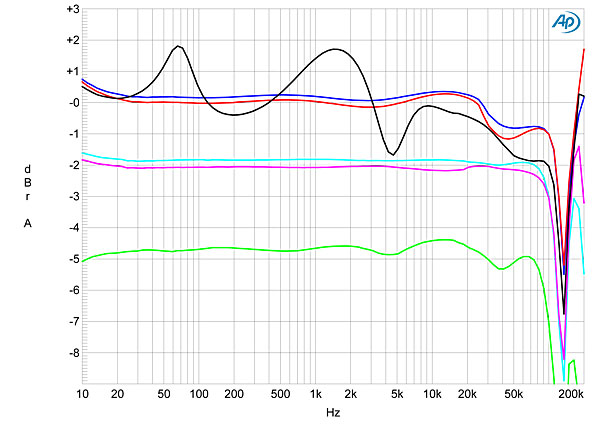
And here's how transistor amps tend to perform under similar situations. Do please pay attention to the difference in the dB scale between the two.
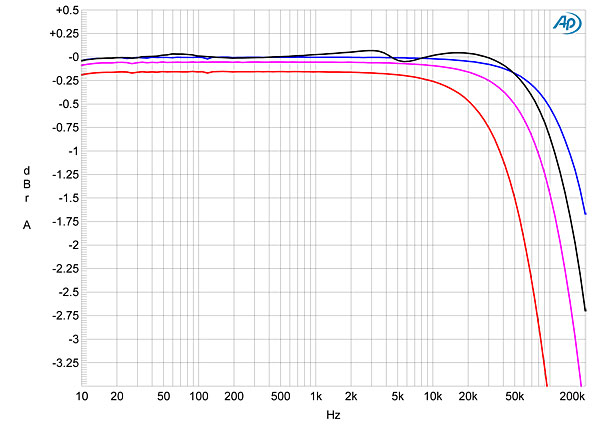
Changing the internal cabling will have next to no effect.
Below you can see a comparison of a loudspeaker I designed on the left with the KEF on the right.
The graphs show the electrical transfer functions of what the filters do. Tweeters on the top, woofers on the bottom. Reasonably standard values for Re and Le, for 8 ohm drivers, were chosen for the simulation of the KEF xover.
Both the KEF and my design use almost identical topologies, first order and zobel on the woofer with a third order + resistor on the tweeter. I used an L-pad on the tweeter whereas KEF just used a single resistor.
As can be seen the transfer functions follow very similar trends. The electrical phase of the tweeter crossovers is quite different, but that's not a surprise, the KEF uses a co-incident driver, whereas my design does not and was also designed for an odd listening axis too, well above the height of the loudspeaker.
How does this xover perform when combined with the drivers acoustic response?
Extremely well.
Of course this isn't to say that the KEF crossover is flawless, the point however is that the topology does indeed work.
Cables and resistor changes shouldn't make a lot of difference, and, FWIW, cable changes affect sound because they present a changed load to a class AB amplifier at the top end IMO. Transistor amps are very sensitive to high frequency load. It can dramatically change the Q at rolloff. Perhaps up to 3dB change in HF level.
Huh? First you say cables and resistor changes shouldn't make a lot of difference and then you go on to say that small change in the load can affect the frequency response by up to 3dB in places. Which one is it? You can't have both.
For what it's worth transistor amps are extremely good at coping with changes in the connected load, where a wildly varying impedance wont affect the voltage seen at the loudspeakers terminals. Valve amplifiers on the other hand are notorious for introducing load variable changes in their output voltage.
Here is an example of how bad valve amplifiers can get.

And here's how transistor amps tend to perform under similar situations. Do please pay attention to the difference in the dB scale between the two.

Changing the internal cabling will have next to no effect.
Attachments
RAART,
The link which you provided is showing how to make a low inductance speaker cable. This cable is connected from amplifier to speaker. I use Monster HPXP speaker cable because it sounds good, easy to find,and not expensive.
Monster XPHP™ Clear Jacket - Advanced Speaker Cable
You can find this cable at Future Shop
Monster Cable 15.2M (50 ft.) Speaker Cable (XPHP-50 MKII) : Speaker Wire - Future Shop
I guess that you may prefer more high end, low inductance speaker cables.
I don't have chance to use those low inductance speaker cables.
Partsconnecxion has Kimber cable which is similar to the cable from your link.
wire_speaker_kimber
The most expensive component which I have ever paid for is V Cap OIMP capacitor which is also from Partsconnexion
Oil Impregnated Metalized Polypropylene Audio capacitors by V-Cap
The link which you provided is showing how to make a low inductance speaker cable. This cable is connected from amplifier to speaker. I use Monster HPXP speaker cable because it sounds good, easy to find,and not expensive.
Monster XPHP™ Clear Jacket - Advanced Speaker Cable
You can find this cable at Future Shop
Monster Cable 15.2M (50 ft.) Speaker Cable (XPHP-50 MKII) : Speaker Wire - Future Shop
I guess that you may prefer more high end, low inductance speaker cables.
I don't have chance to use those low inductance speaker cables.
Partsconnecxion has Kimber cable which is similar to the cable from your link.
wire_speaker_kimber
The most expensive component which I have ever paid for is V Cap OIMP capacitor which is also from Partsconnexion
Oil Impregnated Metalized Polypropylene Audio capacitors by V-Cap
There isn't really anything special to a low inductance speaker cable, all you have to do is twist the two conductors together.
Inductance results by the setting up of magnetic fields within conductors. If current flows down a conductor it will create a magnetic field. With every electrical signal flowing down a wire, there will be a return current flowing down another wire that is equal to the signal current. In other words the signal flowing through the red speaker cable is the same as flows through the black, only in the opposite direction. These signals set up magnetic fields within their respective conductors, if you twist the two conductors together tightly the magnetic fields cancel and are greatly diminished, preventing anything from being 'induced', this in turn reduces the inductance of the cabling system.
This is at least how I've understood it.
Inductance results by the setting up of magnetic fields within conductors. If current flows down a conductor it will create a magnetic field. With every electrical signal flowing down a wire, there will be a return current flowing down another wire that is equal to the signal current. In other words the signal flowing through the red speaker cable is the same as flows through the black, only in the opposite direction. These signals set up magnetic fields within their respective conductors, if you twist the two conductors together tightly the magnetic fields cancel and are greatly diminished, preventing anything from being 'induced', this in turn reduces the inductance of the cabling system.
This is at least how I've understood it.
I used kimber cable prior with mixed impressions but that link I posted use low inductance cable which I want to use and try. I probably will order those ones from states while I just went to store I know and they didn't have nothing similar. Anyway, while this is not the topic of the tread, short story, will place an order from Parts express... If interested I will let you know later the audio impressions. 😀
There isn't really anything special to a low inductance speaker cable, all you have to do is twist the two conductors together.
Inductance results by the setting up of magnetic fields within conductors. If current flows down a conductor it will create a magnetic field. With every electrical signal flowing down a wire, there will be a return current flowing down another wire that is equal to the signal current. In other words the signal flowing through the red speaker cable is the same as flows through the black, only in the opposite direction. These signals set up magnetic fields within their respective conductors, if you twist the two conductors together tightly the magnetic fields cancel and are greatly diminished, preventing anything from being 'induced', this in turn reduces the inductance of the cabling system.
This is at least how I've understood it.
I understood this the same way... I do have only one question for you while that guy used carbon sleeving (cosmetic purpose) I do have nice metal mesh sleeving( looks like silver, have a shine in it 🙂) do you think if I cover twisted cables with this will have some additional effect? I will get probably form electrical store just generic 16 AWG stranded purest copper cable they have there on Mon. while they are closed today...
The only thing that I can think that it would do, besides looking pretty, is that the metal will act as a shield. Any magnetic field created within the wire should be redirected around the mesh reducing the level of any radiated EMI. It may also reduce the effect that any EMI might have on the loudspeakers. Of course loudspeakers and their amplifiers tend to work at very low impedances so they'd be hard for any EM field to influence in the first place.
So technically it will do something, just like using low inductance wiring or low inductance resistors will do something, it's just that this something is unlikely to be in any way apparent in the given application. Of course this also depends on how long the runs of wire are too, but in that respect keeping the resistance of the cables below ~10% of the minimum impedance of the loudspeakers should be the real priority.
Even if it is likely to be inaudible, I am all for doing things that will provide some technical benefit, if said things are easy and cheap to implement. What I don't like seeing are people spending large amounts of money on things that are unlikely to have any decent effect.
So technically it will do something, just like using low inductance wiring or low inductance resistors will do something, it's just that this something is unlikely to be in any way apparent in the given application. Of course this also depends on how long the runs of wire are too, but in that respect keeping the resistance of the cables below ~10% of the minimum impedance of the loudspeakers should be the real priority.
Even if it is likely to be inaudible, I am all for doing things that will provide some technical benefit, if said things are easy and cheap to implement. What I don't like seeing are people spending large amounts of money on things that are unlikely to have any decent effect.
The only thing that I can think that it would do, besides looking pretty, is that the metal will act as a shield. Any magnetic field created within the wire should be redirected around the mesh reducing the level of any radiated EMI. It may also reduce the effect that any EMI might have on the loudspeakers. Of course loudspeakers and their amplifiers tend to work at very low impedances so they'd be hard for any EM field to influence in the first place.
So technically it will do something, just like using low inductance wiring or low inductance resistors will do something, it's just that this something is unlikely to be in any way apparent in the given application. Of course this also depends on how long the runs of wire are too, but in that respect keeping the resistance of the cables below ~10% of the minimum impedance of the loudspeakers should be the real priority.
Even if it is likely to be inaudible, I am all for doing things that will provide some technical benefit, if said things are easy and cheap to implement. What I don't like seeing are people spending large amounts of money on things that are unlikely to have any decent effect.
I thought too that will act as well as some kind of shielding otherwise I will not even mention it at all. Just need reconfirmation... Thx. 😉
Friends, if I can cal you guys friends, this might sound even crazier to you then before but in terms of KEF x-over I might go slightly different route and that might upset some of you and some might say Bravo!!!
For sure this will be a very different iQ30 then some of you know but that's where I want to go.
The values on the capacitors will be changed. Good thing is I didn't order them while got cold/flu/fever... Right now to get rid of some sound impurities the values will be changed. Resistors will be changed too, just to match quality of other components too. Inductors, just the ferrite cored one.
X-over might have a slightly different design too. But that might happen later after this x-over is modified...
Not a surprise for me, while I strive to get best of everything, but this might surprise some of you...
Cheers! 😀
For sure this will be a very different iQ30 then some of you know but that's where I want to go.
The values on the capacitors will be changed. Good thing is I didn't order them while got cold/flu/fever... Right now to get rid of some sound impurities the values will be changed. Resistors will be changed too, just to match quality of other components too. Inductors, just the ferrite cored one.
X-over might have a slightly different design too. But that might happen later after this x-over is modified...
Not a surprise for me, while I strive to get best of everything, but this might surprise some of you...
Cheers! 😀
Did someone audition already KEF LS50? Just impressions please if yes, while in the near future I might order this one.. If I have enough funds for it...
Last edited:
Just to update my progress... I will keep intact original x-overs for iQ30 however I will build new XO with generous help from some forum members here - Thank you guys!
While the new x-overs will be different I missing only XQ20 service manual (have already iQ3 and iQ30 service manual) then I will start to work on it. I hope that soon I will find one or if someone here who has the schematics for the XQ20 x-over, please post it here. That will be generous help but at the end all of us will be benefit while I will post all values and schematics of the new XO I will build hopping that everyone who has iQ30 can benefits from it.
While all of you guys here are great I will post something that I put together. While I think that XQ20 x-overs should be very similar constructed like XQ30 or XQ40 and they feature separate HF, MF and LF x-overs. Please take a look at pdf files I put together but unfortunately the schematics are not very clear (the best I can get from the net is this). If someone has more clear schematics please PM me and I will let you know my email address where you can send those files and I will put everything together and post it here that everyone can have access. 😉
While the forum has a file limit I posted each page separately... 😀

P.S. Sorry for the previous post... I actually wanted to post it somewhere else... Didn't realize until now that I posted here... 😱
While the new x-overs will be different I missing only XQ20 service manual (have already iQ3 and iQ30 service manual) then I will start to work on it. I hope that soon I will find one or if someone here who has the schematics for the XQ20 x-over, please post it here. That will be generous help but at the end all of us will be benefit while I will post all values and schematics of the new XO I will build hopping that everyone who has iQ30 can benefits from it.
While all of you guys here are great I will post something that I put together. While I think that XQ20 x-overs should be very similar constructed like XQ30 or XQ40 and they feature separate HF, MF and LF x-overs. Please take a look at pdf files I put together but unfortunately the schematics are not very clear (the best I can get from the net is this). If someone has more clear schematics please PM me and I will let you know my email address where you can send those files and I will put everything together and post it here that everyone can have access. 😉
While the forum has a file limit I posted each page separately... 😀

P.S. Sorry for the previous post... I actually wanted to post it somewhere else... Didn't realize until now that I posted here... 😱
Attachments
-
KEF XQ40 - from service manual - RAART P4.pdf179.6 KB · Views: 141
-
KEF XQ40 - from service manual - RAART P3.pdf114.6 KB · Views: 235
-
KEF XQ40 - from service manual - RAART P2.pdf93.8 KB · Views: 240
-
KEF XQ40 - from service manual - RAART P1.pdf10.9 KB · Views: 282
-
KEF XQ30 - from service manual - RAART P4.pdf125.1 KB · Views: 150
-
KEF XQ30 - from service manual - RAART P3.pdf134.1 KB · Views: 152
-
KEF XQ30 - from service manual - RAART P2.pdf124.2 KB · Views: 149
-
KEF XQ30 - from service manual - RAART P1.pdf10.9 KB · Views: 201
RAART, I'm struggling to keep this post short. But what I think is going on is that your KEF iQ30 speakers are STRUGGLING and it's hard to fix.
Problem is the TINY little concentric metal tweeters are very inefficient and driving impedance too low to give you any room to manouvre with the usual fixes.
The 1.2 ohm resistance driving a TINY 0.1mH coil is giving you a low impedance of around 3 ohms at 5kHz. Not good.
You have the usual metal dome problem of harshness and metallic colouration on classical music. I have yet to hear a metal dome that can render piano accurately. I did fix the impedance with a second order filter and tame the metallic tonality with a Zobel at the cost of some power handling. The Zobel needs some work from you though, because I don't accurately know the inductance or resistance of the tweeter.
An externally hosted image should be here but it was not working when we last tested it.
Problem is the TINY little concentric metal tweeters are very inefficient and driving impedance too low to give you any room to manouvre with the usual fixes.
The 1.2 ohm resistance driving a TINY 0.1mH coil is giving you a low impedance of around 3 ohms at 5kHz. Not good.
You have the usual metal dome problem of harshness and metallic colouration on classical music. I have yet to hear a metal dome that can render piano accurately. I did fix the impedance with a second order filter and tame the metallic tonality with a Zobel at the cost of some power handling. The Zobel needs some work from you though, because I don't accurately know the inductance or resistance of the tweeter.
Attachments
Last edited:
- Status
- Not open for further replies.
- Home
- Loudspeakers
- Multi-Way
- x-over for Kef iQ30
